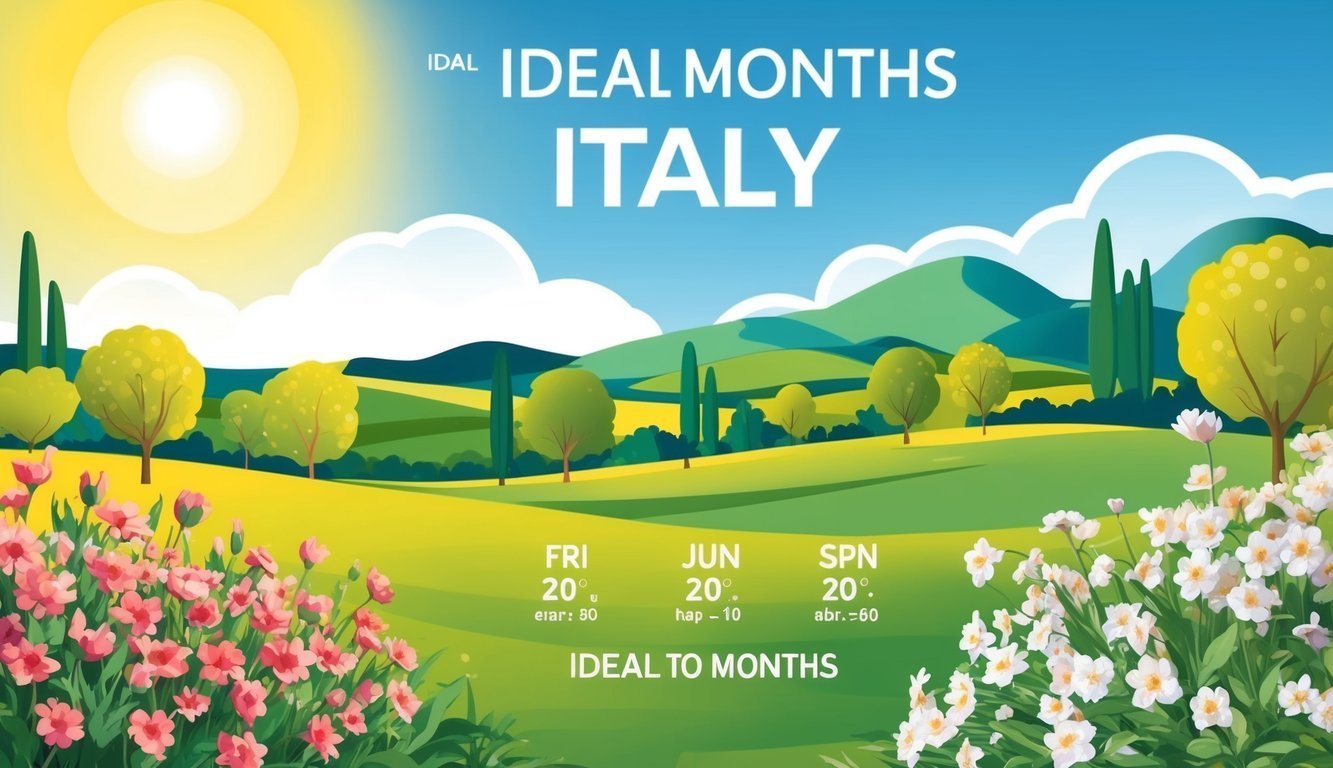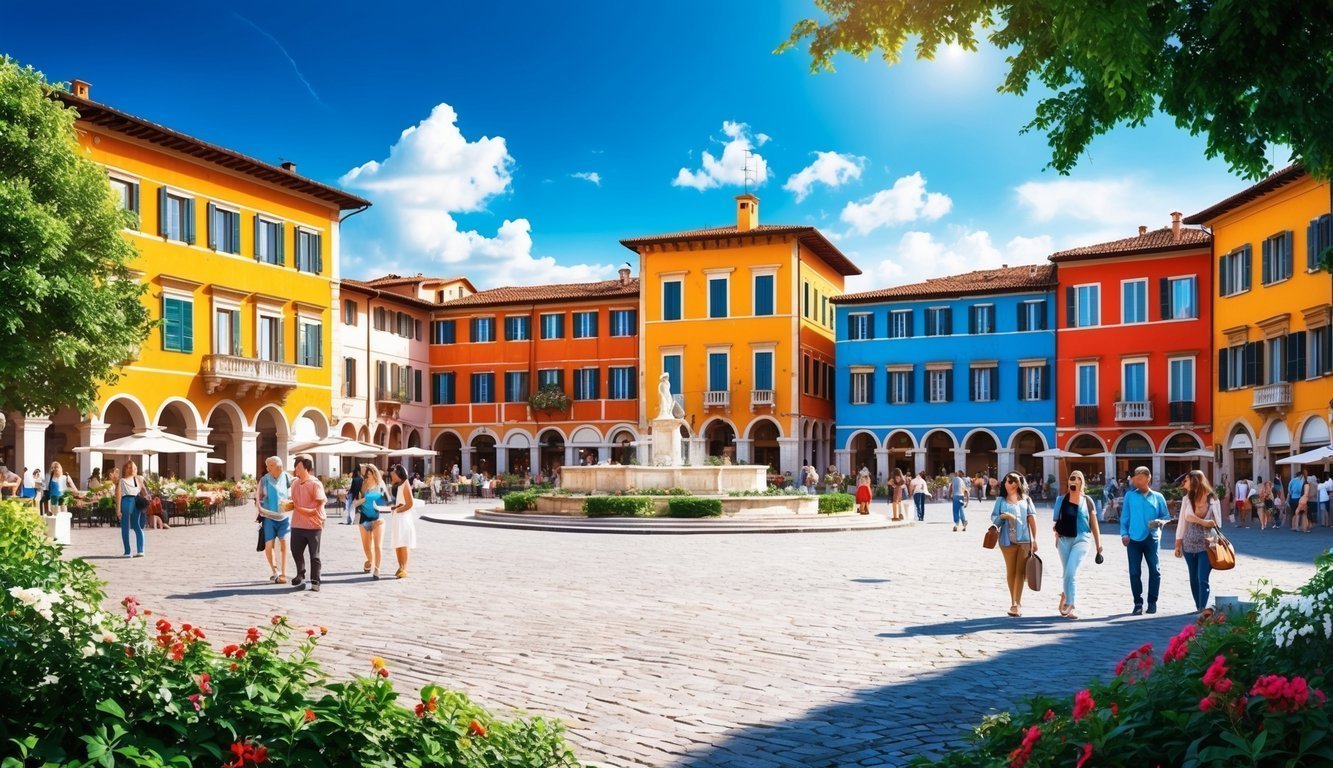When planning your trip to Italy, the timing can greatly affect your experience.
Certain months offer better weather, fewer crowds, and more enjoyable sightseeing opportunities.
Understanding which months provide the best conditions will help you make the most of your Italian adventure.
Traveling during the right months can transform your journey.
You’ll find it easier to explore charming towns, visit famous landmarks, and enjoy local festivals when you choose wisely.
Keep reading to discover the perfect months for an unforgettable visit to Italy.
Understanding Italy’s Climate

Italy’s climate can change quite a bit depending on when and where you visit.
Knowing how seasons vary and how geography affects weather is key for your trip.
Italy has a mix of Mediterranean, alpine, and continental climates, making it important to understand what to expect.
Overview of Seasonal Variations
Italy experiences four distinct seasons: spring, summer, autumn, and winter.
- Spring (March to May) brings mild weather with temperatures ranging from 50°F to 70°F. It’s a great time for blooming flowers and fewer tourists.
- Summer (June to August) can be hot, especially in July and August. You might see temperatures reach the 80s and 90s°F. Coastal areas offer some relief with nice breezes.
- Autumn (September to November) is lovely, with warm temperatures from the 70s°F in September to cooler weather by November. It’s a perfect time to have fewer crowds.
- Winter (December to February) can be cold, especially in northern Italy, where snow is common. Southern regions remain milder but still chilly.
Impact of Geography on Weather
Italy’s diverse geography dramatically affects its climate.
The northern regions, like the Alps, experience cold winters and heavy snowfall, perfect for skiing.
In contrast, the coastal areas have more moderate temperatures year-round.
- Northern Italy: Expect colder, wetter weather during winter and pleasant summers.
- Central Italy: Cities like Rome enjoy a Mediterranean climate with hot summers and mild winters.
- Southern Italy: This region is typically warmer throughout the year, especially in coastal areas where temperatures rarely drop below 50°F.
Understanding these factors helps you pick the best time to explore each part of Italy.
Travel Tips for Visiting Italy
When planning your trip to Italy, it’s important to pack wisely and be ready for the crowds.
Knowing what to bring can make your experience much more enjoyable.
Also, understanding how to navigate busy tourist areas helps you make the most of your time.
Packing Essentials for Different Seasons
Your packing list should change depending on when you visit Italy.
In spring (March to May), bring layers.
Temperatures can swing between cool mornings and warmer afternoons.
Think light jackets, comfortable shoes, and nice clothes for Easter festivities.
In summer (June to August), it’s hot! Pack lightweight clothing, sun hats, and sunscreen.
Don’t forget your reusable water bottle; staying hydrated is key.
Autumn (September to November) is gorgeous.
It’s cool, with colorful leaves.
Bring sweaters and scarves for chilly evenings.
If you visit in winter (December to February), you’ll want warm clothing.
Layers, a good coat, and sturdy shoes are a must, especially if you explore snow-covered areas.
Navigating Tourist Crowds
Italy can get crowded, especially in popular destinations like Rome, Venice, and Florence.
To dodge the thickest crowds, visit major sites early in the morning or later in the afternoon.
Midweek trips can also help you avoid busy weekends.
Consider booking timed entry tickets for sights such as the Colosseum or the Uffizi Gallery.
This lets you skip long lines.
Also, wandering off the beaten path can lead to fantastic discoveries.
Explore lesser-known neighborhoods or smaller towns to experience authentic Italian life away from crowds.
Always be aware of pickpockets, especially in busy areas.
Keep your belongings close, and consider using a crossbody bag.
Frequently Asked Questions

Traveling to Italy brings up many questions, especially about the best times to visit and how to have a great experience.
Here are some answers to common queries that can help you plan your trip.
What are the best months to go to Italy?
The best months to visit Italy are typically April, May, September, and October.
During these times, the weather is pleasant, and tourist crowds are smaller, allowing you to explore the sights more easily.
Which part of the year offers the best deals for traveling to Italy?
Traveling in the winter months, particularly from November to February, can offer the best deals.
Prices for accommodations and flights tend to be lower during this off-peak time, making it a cost-effective option for visitors.
How can I avoid the crowds when visiting Italy?
To avoid crowds, consider visiting less popular attractions or traveling during shoulder seasons like late September and early October.
Early mornings or late afternoons at major tourist sites can also help you experience them with fewer people around.
When’s the off-peak season for a quieter trip to the Amalfi Coast?
The off-peak season for the Amalfi Coast is from November to March.
During these months, you’ll find fewer tourists, allowing you to enjoy the stunning scenery and charming towns without the hustle and bustle of summer crowds.
Is it advisable to visit Italy and Greece in one trip, and when should I go?
Yes, combining Italy and Greece in one trip is doable, especially during the shoulder seasons in spring (April to June) and fall (September to October).
During these times, weather conditions are often perfect for exploring both countries.
What time of year is the climate ideal for enjoying Italy’s beaches?
In Italy, the ideal time for beach weather is from June to September.
July and August are the hottest months.
They are perfect for sunbathing and swimming, though they can also be crowded on popular beaches.
